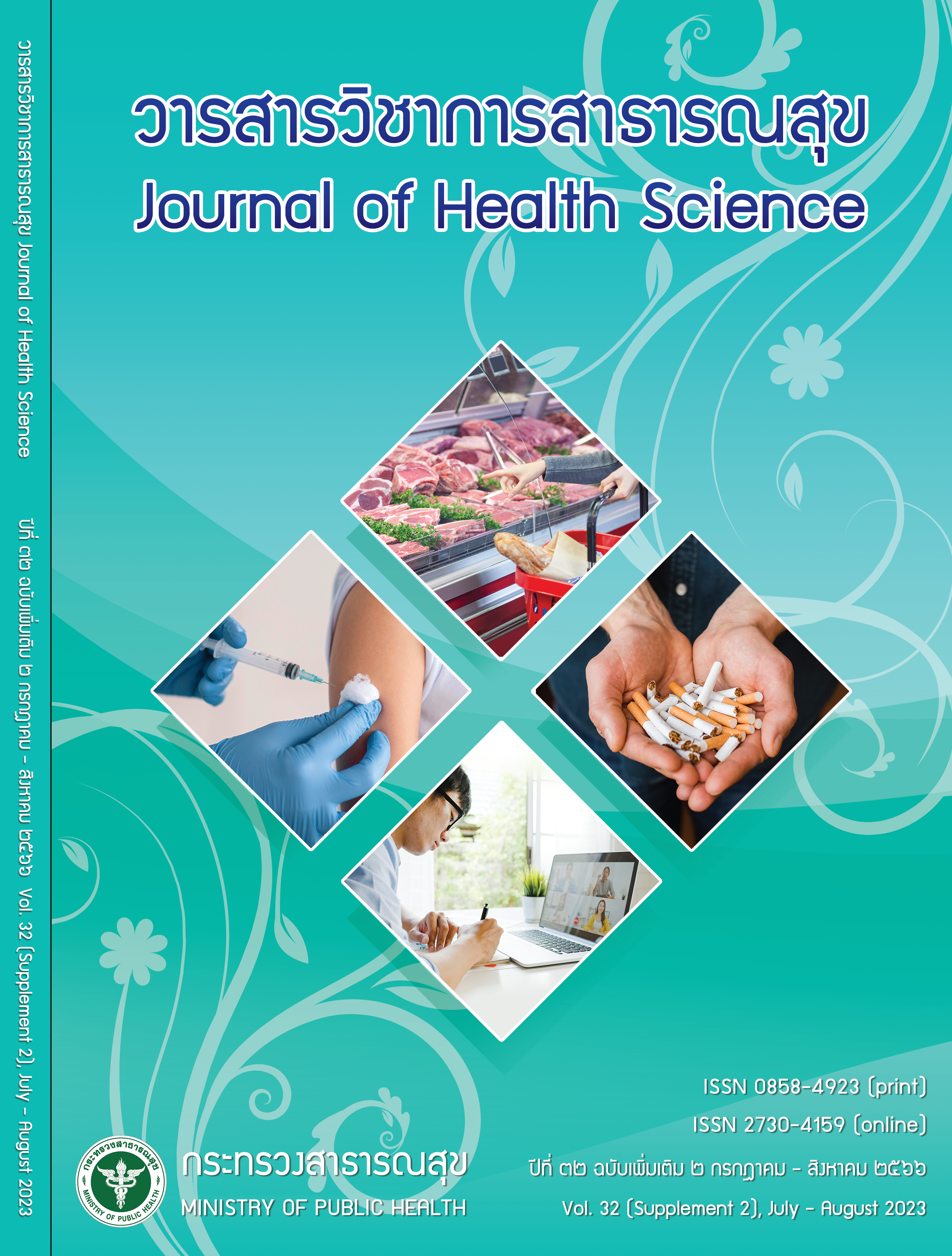Detection of Antimicrobial Agent in Meat in Thonburi Area, Bangkok
Keywords:
meat, antimicrobial agent, supermarkets, marketsAbstract
Thailand is a country of agricultural society where large numbers of animals are raised for consumption and export, especially pork, chicken, and shrimp. In animal husbandry, antimicrobial agents are used to accelerating growth, prevent, and treat diseases. Nowadays, the trend of using antimicrobials in animal husbandry has become an important public health problem for consumers. The purpose of the present research was to analyze antimicrobial residues in white shrimp, chicken, and pork sold in markets and supermarkets in the Thonburi area, Bangkok with 105 samples (35 samples per type) for three groups of antimicrobial dominance (group A: tetracycline; group B: macrolide; aminoglycoside; sulfonamide; and group C: penicillin). The results showed that shrimp and chicken had the most group B antimicrobial residues (97.1 and 85.7%, respectively), while pork had the most residues of group C antimicrobials (71.4%). Group B antimicrobial residues in shrimp, chicken, and pork samples were statistically different (p<0.05). In addition, 83 samples (79.0%) of meat with more than one group of antimicrobial residues were found. The results of this study indicate that antimicrobial residues are common in animal husbandry processes. The situation of antimicrobial residues in meat should be continuously monitored for surveillance of the spread of antimicrobial agents and microorganisms to the environment and the safety of meat consumption.
Downloads
References
Codex Alimentaris Commission. Request for revision/ information to the database on countries’ needs for MRLs [Internet]. 2016 [cited 2021 Nov 25]. Available from: http://www.fao.org/fao-who-codexalimentarius/shproxy/en/?Ink=1&url=http%253A%252F%252F%20 workspace.fao.org%252Fsites%252Fcodex%252FCircular%252520Letters%252FCL%2525202016- 42%252FCL16_42e.pdf
ใจพร พุ่มคำ. อาหาร (ไม่) ปลอดภัย ผลจากการใช้ยาปฏิชีวนะในสัตว์. วารสารอาหารและยา 2555;19(3):8-11.
นาถสุดา จามธรัญญวาท. การตรวจคัดกรองหายาปฏิชีวนะ ตกค้างในเนื้อไก่จากตลาดเขตเทศบาลขอนแก่นโดยชุดตรวจสอบ KS-9. วารสารวิจัย มข 2543;5(1):72-5.
ชุมพล นาครินทร์, อดิศร ชาติสุภาพ. การตรวจหายาต้าน จุลชีพตกค้างในเนื้อสุกร เนื้อโค และเนื้อไก่ในพื้นที่จังหวัด ชัยภูมิ [อินเทอร์เน็ต]. 2553 [สืบค้นเมื่อ 18 ก.ย. 2564]. แหล่งข้อมูล: http://certify.dld.go.th/certify/index.php/ th/2016-05-01-14-51-22/2016-05-03-03-24- 22/69-2016-05-18-08-09-40
สถิตคุณ ไมตรีจิต, สิทธิณี ปฐมกำธร, ส่งศักดิ์ ศรีสง่า, พันธ์ทิพย์ หินหุ้มเพ็ชร. การตกค้างของยาปฏิชีวนะในเนื้อ สุกรและเนื้อโคสดที่จำหน่ายในบริเวณตลาดสด อำเภอเมือง จังหวัดพิษณุโลก. วารสารสาธารณสุขศาสตร์ มหาวิทยาลัยนเรศวร 2564;3(3):16-28.
ธงชัย เฉลิมชัย, สุรศักดิ์ ดิลกเกียรติ, ส่งศักดิ์ ศรีสง่า, นภาพร เลิศวรปรีชา. การเปรียบเทียบผลการตรวจยาปฏิชีวนะ ตกค้างหลังการหยุดยาอ็อกซี่เตตร้าซัยคลิน ซัลฟาเม็ทท็อก ซาโซล ซัลฟาเม็ทท็อกซาโซล+ทรัยเม็ทโทปริม และเอ็นโรฟล็อกซาซินในกุ้งขาว (Penaeus vannamei) โดยวิธีไมโครเบียลอินฮิบิชั่นดิสค์แอสเสย์ และชุดตรวจสอบยาปฏิชีวินะ ตกค้าง “แซมเทสท์”. วารสารสงขลานครินทร์ วทท 2548; 21(ฉบับพิเศษ 1):283-90.
รัตนาภรณ์ ศรีวิบูลย์, อุดมลักษณ์ ธิติรักษ์พาณิชย์. การตรวจ หาสารปฏิชีวนะตกค้างในอาหารทะเลและผลิตภัณฑ์อาหารทะเล [อินเทอร์เน็ต]. 2551 [สืบค้นเมื่อ 19 ก.ย. 2564]. แหล่งข้อมูล: http://dspace.lib.buu.ac.th/handle/1234567890/387
รพีพัฒน์ นาคีภัย, สุพัตรา บุตราช, สุขกมล เกตุพลทอง. อัตราอุบัติการณ์สารกลุ่มเตตราซัยคลินตกค้างในกุ้งเขตพื้นที่จังหวัดมหาสารคาม. วารสารวิจัย 2564;14(1):66- 73.
นริศร นางงาม, สรรเพชญ อังกิติตระกูล, พิทักษ์ น้อยเมล์, วสันต์ จันทรสนิท. การเปรียบเทียบประสิทธิผลของการตรวจ คัดกรองหายาปฏิชีวนะตกค้างในไก่เนื้อและไข่ไก่โดยใช้วิธี ทริปเปิลมีเดี่ยมด้วยไตรเมทโทพริม วิธียูโรเปี่ยนโฟรเพลทเทสและวิธีเทคนิคทิวดิฟฟิ วชั่น. วารสารสัตวแพทยศาสตร์ มข 2547;14(1):8-18.
เกรียงศักดิ์ สายธนู, ธงชัย เฉลิมชัยกิจ. KS-9 ชุดตรวจสอบ ยาปฏิชีวนะตกค้างในโคนมและผลิตภัณฑ์. กรุงเทพมหานคร: คณะสัตว์แพทย์ศาสตร์ จุฬาลงกรณ์มหาลัย; 2541.
วรางคณา ไชยซาววงษ์, ชุลีพร ศักดิ์ สง่าวงษ์, รวิศา วรินทร์, รัชฎาพร บริพันธุ์, จำรัส เลิศศรี, มนทิรา อินต๊ะนอน. ประสิทธิภาพของชุดทดสอบยาต้านจุลชีพตกค้างในเนื้อสัตว์โดยใช้หลักการยับยั้งเชื้อจุลชีพ. เชียงใหม่สัตวแพทยสาร 2561;16(1):27-36.
โสภณ อ่อนคง, อมรรัตน์ เสริมวัฒนากุล, ชุติมา ตันติกิติ. การตกค้างของยาปฏิชีวนะออกซิเตทตราซัยคลินในกุ้งกุลาดำ (Penaeus vannamai) ที่เลี้ยงในบ่อซีเมนต์และบ่อดิน. วารสารสงขลานครินทร์ 2543;22(ฉบับพิเศษ):717-24.
สารี อ๋องสมหวัง, นิยดา เกียรติยิ่งอังศุลี. การตกค้างของ ยาปฏิชีวนะในอกไก่และตับไก่สด [อินเทอร์เน็ต]. 2561 [สืบค้นเมื่อ 8 ก.ค. 2564]. แหล่งข้อมูล: https://www. consumerthai.org/consumers-news/consumers-news/ food-and-drug/4218-610619antibiotic.html14. Jammoul A, Darra NE. Evaluation of antibiotics residues in chicken meat samples in Lebanon. Antibiotics 2019; 8(2):69-79.
จุไรรัตน์ รุ่งโรจนารักษ์, ดวงดาว วงศ์สมมาตร์, ปรีชา จึงสมานุกูล. การพัฒนาชุดทดสอบยาปฏิชีวนะและสารต้านจุลชีพตกค้างในเนื้อสัตว์. วารสารกรมวิทยาศาสตร์การแพทย์ 2544;43(ฉบับพิเศษ 1):113-29.
ดวงดาว วงศ์สมมาตร์, สมภพ วัฒนมณี. สถานการณ์ของ สารต้านจุลชีพตกค้างในเนื้อสัตว์ในภาคกลางของประเทศไทย. วารสารกรมวิทยาศาสตร์การแพทย์ 2550;49(2);144- 56.
Downloads
Published
How to Cite
Issue
Section
License

This work is licensed under a Creative Commons Attribution-NonCommercial-NoDerivatives 4.0 International License.



